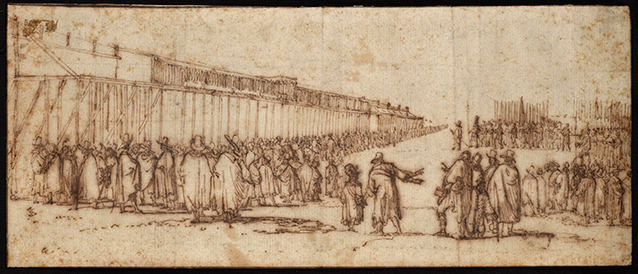The Infant Louis XIV inspecting a Military Tattoo at the Louvre 1642 - 1650
Della Bella, Stefano
* 1610 in Florence † 1664 in Florence
Pen and brown ink. Size of sheet: 10.4 x 25.1 cm.
Watermark: bird inscribed in a circle with letter above, similar to Briquet 12.205 (Florence 1496).
Provenance: Winslow and Anna Ames, Springfield, Missouri (blind stamp, L.2602a);
Ludwig Paar (Ambassador to the Vatican) Paar Sale, Vienna February 1896 as Jacques Callot, lot. 302 (Witt Library);
Alte Galerie, Landesmuseum Joanneum, Graz (museum stamp, L.2709).
The first connection between the present drawing and Florentine artist Stefano della Bella was made by Hugo Chapman from the British Museum (1).
Known for etchings of a great variety of subjects, including military and court scenes, landscapes, and lively genre scenes, della Bella moved to Paris in 1639 having been introduced by the Tuscan ambassador, Alessandro del Nero. He lived there until 1650, adapting his style to French taste. The majority of della Bella’s prints date from his time in Paris; he arrived four years after the death of Callot, and was already acquainted with French publishers. In 1641 Cardinal Richelieu sent him to Arras to make drawings for prints of the siege by the royal army, and in 1644 Latterly Cardinal Mazarin commissioned four sets of educational playing cards for the young Louis XIV.
A very clear pentimento in the present drawing suggests that it could have been executed in loco by della Bella during a Military Tattoo in front of the Louvre, showing the Infant Louis XIV three quarters from behind in the centre-right of the scene. The drawing was perhaps a study for a never made print.
French anti-Italian sentiments during the Fronde, and the death of Mazarin probably forced della Bella's return to Florence, where he obtained a pension from the grand duke, whose son, Cosimo III de Medici, he instructed in drawing. Nevertheless, he continued to send plates to Paris publishers. In his final years he produced a number of prints experimenting with tonal effects, though these were little known at the time; he had long made much use of wash in his drawings, and was now attempting with considerable success to achieve similar effects in etching, though only a few good impressions could be taken from the plate. In 1661 he appears to have suffered a stroke, after which he produced little work.
(1) To the previous owner.
£ 8,500.-
